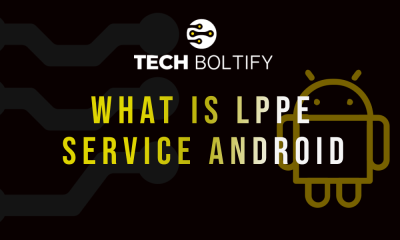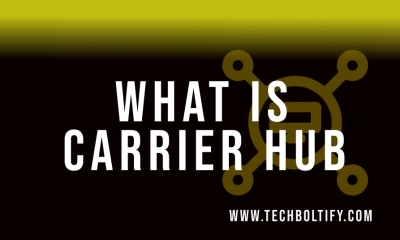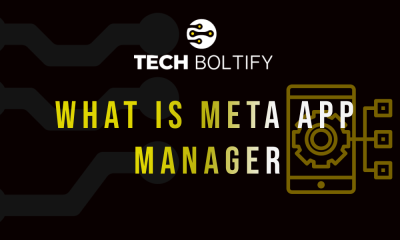Tech
Cost-Benefit Analysis of Cloud-Centric Mobile Architectures
The world is racing towards the digital space, and the integration of cloud mobile phone technology into mobile architectures transforms application development and delivery. Cloud-centric mobile architectures take advantage of cloud computing to make applications more performance-oriented, scalable, and accessible.
This article performs a cost-benefit analysis based on the merits and challenges surrounding the adoption of cloud-centric mobile architectures. This further highlights the importance of cloud testing in such scenarios so that it can guarantee functioning with high exactness of efficiency on any type of device or platform.
Understanding Cloud-Centric Mobile Architectures
Cloud-centric mobile architectures denote the union of advanced forms of mobile devices and cloud computing infrastructure. It serves as an improved environment both in terms of developing applications as well as deployment. This architecture allows mobile applications to offload heavy processing tasks to the cloud. So, they can run quite well on devices that have a limited amount of computing power.
Developers can make mobile applications more capable and responsive, as this will ensure that the functionalities can be handled without overburdening the local resources of the device by tapping into the cloud resources.
Key Components of Cloud-Centric Architectures
This architecture comprises three primary components:
Mobile Devices
These included the User Interface (UI) of the smartphones and tablets that provide the users with a gateway to the respective cloud services and applications. They helped a user interact with resources in the cloud in a friendly manner.
Cloud Infrastructure
This includes data centers and cloud services that back-end support storage, processing, and hosting of applications. To handle the greater burden of heavy lifting data processing and storage requirements of mobile applications, there is a need for cloud infrastructure.
Communication Networks
Technologies such as Wi-Fi and 4G/5G offer connectivity between mobile devices and cloud resources. Communication networks are the backbone of cloud services, providing reliable access to cloud services and enabling real-time data exchange and application performance.
Benefits of Cloud-Centric Mobile Architectures
The various benefits that come with cloud-centric mobile architectures lead to a large increase in the development, deployment, and User Experiences (UX) of mobile applications. With the resources of cloud computing, the organization could make its operations and services better.
Scalability
Scalability benefits are among the most important for those cloud-centric mobile architectures. They can easily scale their applications based on the needs of users without a significant investment in extra hardware.
This helps organizations rapidly respond to changing market conditions by absorbing peaks in user activity or expanding services without being restrained by the physical infrastructure in which the ‘brains’ of the software are. Cloud resources are adjusted dynamically as the needs of users change.
Cost Efficiency
Another key benefit is cost efficiency. With cloud computing services, the capital expenditure organizations incur on maintaining infrastructure is diminished.
Cloud computing services offer a pay-as-you-go model that ensures operational expenditure is easier to handle since the organizations are charged for the exact quantity of resource utilization. It does not plow more resources into hardware and maintenance. Rather, such infrastructures are provided to organizations for organizational innovations.
Enhanced Performance
The cloud-centric mobile architectures improve the performance of the testing process. Resource-intensive tasks are offloaded to the cloud, thus making applications run more smoothly on otherwise underpowered mobile devices. That way, users enjoy faster loads and responsiveness, even when working with more complex applications or handling large datasets.
The cloud’s computational power can then be harnessed to make applications richer and more engaging without compromising device performance.
Real-time Data Access
Real-time data access is one of the benefits of cloud-centric mobile architectures. Users can easily access data and applications from any place, which increases flexibility and usability. It improves the UX because information and services are available in real-time, and this is very important when users need quick digital solutions today.
Any person can acquire information from anywhere using cloud-based applications: applications that assure timely delivery of information and efficient functioning.
Cost-Benefit Analysis of Shifting to Cloud-Centric Mobile Architecture
When an organization feels the urge to switch over to a cloud-centric mobile architecture, there will be a cost-benefit analysis that will encompass the direct and indirect costs of the change. This is normally important to ascertain the cost implications of such a decision and establish if the change is worthwhile since its benefits are more significant than the costs.
Direct Costs
Direct costs can easily be measured; they usually refer to subscription fees, migration costs, and the cost of training. Subscription charges are usually month-to-month charges or yearly charges for cloud service, and their sum can reach a significant value over time. Organizations have to compare different models of pricing used by cloud providers to find an optimal solution concerning its cost.
Migration costs would include moving already existing applications into the cloud and may require extra resources, time, and skill, thus calling for possible consultants or internal teams to successfully oversee the migration process.
There will also be some training costs due to the staff being trained in the proper application of new tools and systems via the cloud. Training programs allow employees to gain knowledge and skills that will help in extracting maximum benefits from migrating to cloud technology.
Indirect Costs
Less visible indirect costs are very significant and have a major impact on the bottom-line financial impact of migration. For instance, during the process of migration, a gigantic indirect cost is downtime when the process of migration temporarily interrupts the service, and productivity and revenue are lost. Thus, it will be strategic on the part of organizations to get ready for the reduction of downtime at such a pivotal point.
There is another indirect cost, namely, maintenance itself; though infrastructure is taken care of by the cloud providers, organizations still have to maintain applications. This consists of regular update measures and compliance checks and incurs some more costs. The cloud also raises significant issues in the security risks of storing data. Organizations must make investments in proper security measures and compliance protocols that ensure the information is safe against vulnerabilities.
Other Benefits
The transition to a cloud-centric mobile architecture comes with costs. The pay-as-you-go pricing models will reduce some operational costs on an organizational level because they simply pay for whatever they use as well as all the potential savings, which in most cases are much lower compared to maintaining large on-premises infrastructure.
Also, much greater flexibility shall make it more accessible for a company to comply with fast and frequent changes made in market demand without investing greatly in hardware products. This agility means quicker deployment of new features and services that customers may need.
Also, it includes better collaboration because access to centralized data and applications improves employee teaming and communication, resulting in more effective workflow and project management.
Challenges of Cloud-Centric Mobile Architectures
While there are many benefits to adopting cloud-centric mobile architectures, several challenges need to be considered in the implementation and operation of these architectures. These challenges should be well understood to ensure a successful transition and maximum exploitation of these architectures.
Security Concerns
The use of cloud services certainly has many security concerns about the data that is stored. These organizations have to ensure that sensitive information is safe and protected from breaches and unauthorized use.
The nature of cloud storage, which is always associated with off-site data storage, increases the risk of cyber threats. These risks must be mitigated by putting up very strong security measures.
This includes using encryption to protect data both in transit and at rest, as well as adopting multi-factor authentication to enhance access control. Regular security audits and compliance with industry standards further strengthen the security posture of cloud-centric mobile applications.
Latency Issues
Latency can be the biggest impact when accessing cloud-based applications; it depends on the quality of the internet connection. In cases of poor internet quality, the user will likely experience lags in retrieving data or applications’ response times, thereby degrading performance and enhancing frustration.
Organizations need to try optimizing their network infrastructure so that they avoid latency problems. For example, one can opt for a cloud provider that offers lower-latency alternatives or use Content Delivery Networks (CDNs) to cache data closer to the users for faster access. Moreover, a constant internet connection with high technological communications like 4G/5G may eliminate latencies.
Integration Complexity
The integration of the available systems with new cloud services seems to be tough and might involve a lot of effort. There are several complaints from organizations stating compatibility issues in trying to link legacy systems and newer cloud-based solutions. Such integration demands deep preparations and proper selection of resources to better overcome potential problems.
Organizations should take into account analyzing their current infrastructures, finding the gaps that may prevent successful integration, and working with cloud service providers who have dealt with some integration complexities.
Importance of Cloud Mobile Testing
Organizations need to focus on cloud mobile testing to ensure that applications developed on cloud-centric architectures run well on a variety of devices. This involves testing applications on different environments to discover potential issues before deployment. There are lots of benefits of cloud mobile testing.
Cloud mobile testing guarantees cross-browser compatibility so that applications will run perfectly on numerous browsers and devices. It also allows for automated rapid feedback cycles with automatic testing tools, thus detecting a problem much faster, and it allows developers to have time to solve that problem.
Constant testing gives a very reliable application that will increase customer satisfaction. There are many platforms that offer cloud-based mobile testing and one such platform is LambdaTest.
LambdaTest helps organizations streamline the process of cloud mobile testing, embracing a cloud-centric mobile architecture that in turn enhances application performance and provides satisfactory output for the users.
LambdaTest also automates recurring tasks, saving crucial time to be spent on them. It provides an environment that is updated to the newest security standards while being efficient and budget-friendly in the optimization of mobile application testing.
LambdaTest can play a critical role in enabling organizations to seize the opportunity that cloud technology brings along with keeping their applications reliable and functioning well on every device.
Conclusion
To conclude, cloud-centric mobile architecture facilitates organizations by improving processes used in the application development process. A cost-benefit analysis can help an organization make a suitable decision about the adoption of this technology and counteract security problems and integration issues. There must be strategies followed so that the best performance can be ensured.
Cloud-centric mobile architectures help improve operational efficiency. They get the organization ready for the future in a highly digital environment. Exceptional UXs without performance compromise will be spearheaded through innovative approaches. Moving to a cloud-centric mobile architecture requires careful planning. Based on an assessment of the present infrastructure and what problems may emerge shortly.
Tech
How To Bridge Front-End Design And Backend Functionality With Smarter API Strategy
Introduction: Building More Than Just Screens
We’ve all seen apps that look sharp but crumble the moment users push beyond the basics. A flawless interface without strong connections underneath is like a bridge built for looks but not for weight. That’s why APIs sit at the heart of modern software. They don’t just move data; they set the rules for how design and logic cooperate. When APIs are clear, tested, and secure, the front-end feels smooth, and the backend stays reliable.
The reality is that designing those connections isn’t just “coding.” It’s product thinking. Developers have to consider user flows, performance, and future scale. It’s about more than endpoints; it’s about creating a system that’s flexible yet stable. That mindset also means knowing when to bring in a full-stack team that already has the tools, patterns, and experience to move fast without cutting corners.
Here’s where you should check Uruit’s website. By focusing on robust API strategy and integration, teams gain the edge to deliver features user’s trust. In this article, we’ll unpack how to think like a product engineer, why APIs are the real bridge between design and functionality, and when it makes sense to call in expert support for secure, scalable development.
How To Define An API Strategy That Supports Product Goals
You need an API plan tied to what the product must do. Start with user journeys and map data needs. Keep endpoints small and predictable. Use versioning from day one so changes don’t break clients. Document behavior clearly and keep examples short. Design for errors — clients will expect consistent messages and codes. Build simple contracts that both front-end and backend teams agree on. Run small integration tests that mimic real flows, not just happy paths. Automate tests and include them in CI. Keep latency in mind; slow APIs kill UX. Think about security early: auth, rate limits, and input checks. Monitor the API in production and set alerts for key failures. Iterate the API based on real use, not guesses. Keep backward compatibility where possible. Make the API easy to mock for front-end developers. Celebrate small wins when a new endpoint behaves as promised.
- Map user journeys to API endpoints.
- Use semantic versioning for breaking changes.
- Provide simple, copy-paste examples for developers.
- Automate integration tests in CI.
- Monitor response times and error rates.
What To Do When Front-End and Backend Teams Don’t Speak the Same Language
It happens. Designers think in pixels, engineers think in data. Your job is to make a shared language. Start by writing small API contracts in plain text. Run a short workshop to align on fields, types, and error handling. Give front-end teams mocked endpoints to work against while the backend is built. Use contract tests to ensure the real API matches the mock. Keep communication frequent and focused — short syncs beat long meetings. Share acceptance criteria for features in user-story form. Track integration issues in a single list so nothing gets lost. If you find repeated mismatches, freeze the contract and iterate carefully. Teach both teams basic testing so they can verify work quickly. Keep the feedback loop tight and friendly; blame only the problem, not people.
- Create plain-language API contracts.
- Provide mocked endpoints for front-end use.
- Contract tests between teams.
- Hold short, recurring integration syncs.
- Keep a single backlog for integration bugs.
Why You Should Think Like a Product Engineer, Not Just A Coder
Thinking like a product engineer changes priorities. You care about outcomes: conversion, help clicks, retention. That shifts API choices — you favor reliability and clear errors over fancy features. You design endpoints for real flows, not theoretical ones. You measure impact: did a change reduce load time or drop errors? You plan rollouts that let you test with a small cohort first. You treat security, observability, and recoverability as product features. You ask hard questions: what happens if this service fails? How will the UI show partial data? You choose trade-offs that help users, not just satisfy a design spec. That mindset also tells you when to hire outside help: when speed, scale, or compliance exceeds your team’s current reach. A partner can bring patterns, reusable components, and a proven process to get you shipping faster with less risk.
- Prioritize outcomes over features.
- Measure the user impact of API changes.
- Treat observability and recovery as product features.
- Plan gradual rollouts and feature flags.
- Know when to add external expertise.
How We Help and What to Do Next
We stand with teams that want fewer surprises and faster launches. We help define API strategy, write clear contracts, and build secure, testable endpoints that front-end teams can rely on. We also mentor teams to run their own contract tests and monitoring. If you want a quick start, map one critical user flow, and we’ll help you design the API contract for it. If you prefer to scale, we can join as an extended team and help ship several flows in parallel. We stick to plain language, measurable goals, and steady progress.
- Pick one key user flow to stabilize first.
- Create a minimal API contract and mock it.
- Add contract tests and CI guards.
- Monitor once live and iterate weekly.
- Consider partnering for larger-scale or compliance needs.
Ready To Move Forward?
We’re ready to work with you to make design and engineering speak the same language. Let’s focus on one flow, make it reliable, and then expand. You’ll get fewer regressions, faster sprints, and happier users. If you want to reduce risk and ship with confidence, reach out, and we’ll map the first steps together.
Tech
Which SEO Services Are Actually Worth Outsourcing? Let’s Talk Real-World Wins
Okay, raise your hand if you thought SEO just meant stuffing keywords into blog posts and calling it a day. (Don’t worry, we’ve all been there.) Running a business comes with enough hats already, and when it comes to digital stuff, there’s only so much you can do on your own before your brain starts melting. The world of SEO moves quick, gets technical fast, and—honestly—a lot of it’s best left to the pros. Not everything, but definitely more than people expect. So, let’s go through a few of those SEO services you might want to hand off if you’re looking to get found by the right folks, minus the headaches.
Technical SEO—More Than Just Fancy Talk
If you’ve ever seen a message saying your website’s “not secure” or it takes ages to load, yeah, that’s technical SEO waving a big red flag. This stuff lives under the hood: page speed, mobile-friendliness, fixing broken links, and getting those little schema markup things in place so search engines understand what the heck your pages are about.
You could spend hours (days) learning this on YouTube or DIY blogs, but hiring a specialist—someone who does this all day—saves you a load of stress and guesswork. Sites like Search Engine Journal dig into why outsourcing makes sense, and honestly, after one too many late-night plugin disasters, I’m convinced.
Content Writing and On-Page Optimization (Because Words Matter)
Let’s not dance around it: great content still rules. But search-friendly content is a different beast. It needs to hit the right length, work in keywords naturally, answer genuine questions, and actually keep visitors hooked. Outsourcing writing, especially to someone who actually cares about your brand’s tone, is worth it for most of us.
On-page SEO, which is tweaking all those little details like titles, descriptions, internal links, and image alt text, is a time-eater. It’s simple once you get the hang of it, but when you’re trying to grow, outsourcing makes the most sense.
Link Building—Trickier Than It Looks
Here’s where things get a bit spicy. Backlinks are essential, but earning good ones (not spammy or shady stuff) takes relationship-building, tons of outreach, and real patience. You can spend all month sending emails hoping someone will give your guide a shout-out, or you can just hire folks with connections and a process. Just watch out for anyone promising “hundreds of links for dirt cheap”—that’s usually a shortcut to trouble.
Local SEO—Getting Seen in Your Own Backyard
Ever tried showing up for “pizza near me” only to find yourself on page 7? Local SEO isn’t magic, but it takes a special touch: optimizing your Google Business Profile, gathering reviews, and making sure your info matches everywhere. It’s honestly a job in itself, and most small teams find it way easier to have a local SEO pro jump in a few hours a month.
Reporting and Analytics—Don’t Go Blind
Last, don’t skip out on real reporting. If nobody’s tracking what’s working—and what’s not—you’re just flying blind. Outsourced SEO pros come armed with tools and real insights, so you can see if your money’s going somewhere or just swirling down the drain.
Wrapping Up—Be Realistic, Outsource Smarter
You’re good at what you do, but SEO is more like ten jobs rolled into one. Outsource the parts that zap your time or make your brain itch, and keep what you enjoy. Focus on the wins (more leads, higher rankings, fewer headaches), and watch your business get the attention it deserves.
Tech
White-Label SEO: Building Scalable Digital Marketing Partnerships
Table of Contents
- What Is White-Label SEO?
- Why Digital Agencies Choose White-Label Solutions
- How White-Label SEO Works in Practice
- Benefits for Small and Mid-Sized Agencies
- Risk Management and Quality Assurance
- White-Label SEO and Client Retention
- What to Look for in a White-Label SEO Partner
- Future Trends in White-Label SEO
What Is White-Label SEO?
White-label SEO refers to a business arrangement where an agency partners with a third-party provider to deliver SEO services under the agency’s own brand. Unlike traditional outsourcing, where the client may be aware of third-party involvement, white-label models ensure the service provider remains invisible to the end client. The agency retains control over client communication and branding while benefiting from the expertise and tools of seasoned SEO professionals.
This structure allows agencies to offer complete SEO solutions without needing deep in-house expertise, staffing, or technology. For those looking to deliver robust results while maintaining their branding, leveraging an established provider such as SEO white label by Vazoola is a popular route. As demand for scalable and specialized SEO services grows, white-label partnerships have become a cornerstone for forward-thinking digital marketing agencies.
Why Digital Agencies Choose White-Label Solutions
Agencies of all sizes frequently encounter resource constraints, particularly as clients ask for increasingly sophisticated services. Building an advanced SEO department in-house can be cost-prohibitive, requiring hiring, training, and constant adaptation to search engine algorithm changes. White-label solutions are attractive because they enable agencies to offer first-rate SEO without prohibitive investments.
Additionally, as the digital landscape evolves, clients seek integrated digital marketing strategies instead of disconnected services. With white-label SEO, agencies can rapidly expand their offerings, supporting their growth strategies while capturing a larger market share. This flexibility allows consultancies and digital agencies to remain competitive as demands for comprehensive solutions intensify.

How White-Label SEO Works in Practice
A typical white-label SEO partnership starts with thorough onboarding and aligning goals and processes between the agency and the provider. The agency submits client data and campaign objectives, while the provider crafts a tailored SEO strategy and implementation plan. Once campaigns are underway, the agency oversees communication with its clients, while the provider handles the technical execution—keyword research, link building, technical audits, or content creation.
White-label SEO providers support streamlined communication through client dashboards, branded reports, and regular performance updates. Consistent reporting helps agencies build trust and credibility with their clients without revealing the third-party provider. Workflow automation and transparency are central to success, as illustrated in case studies where agencies have seamlessly scaled from a handful to dozens of clients due to repeatable, managed processes. For further insights, consider Moz’s SEO Guide, a comprehensive resource on industry-accepted best practices.
Benefits for Small and Mid-Sized Agencies
White-label SEO is often a game-changer for small and mid-sized agencies because it equalizes the playing field with larger competitors. These agencies can deliver enterprise-grade SEO services by tapping into top-tier talent and technology while maintaining personalized client relationships. This versatility helps attract and retain clients who might otherwise gravitate toward major digital marketing firms.
Another key advantage is the ability to focus internal teams on their strengths, whether that’s account management, creative work, or strategy. Rather than spreading resources thin, agencies can direct their energy where it adds the most value. By outsourcing technical SEO, they reduce overhead and avoid the risks of hiring, training, and turnover.
Risk Management and Quality Assurance
A significant challenge in white-label SEO is ensuring consistent communication, maintaining transparency, and delivering dependable results. Agencies should adopt robust QA frameworks to monitor campaign progress, verify deliverables, and address issues promptly. Scheduled performance reviews, auditing tools, and transparent project management processes are essential to quality assurance.
To mitigate risks, agencies should establish transparent reporting systems and agree on milestones and metrics upfront. Following the guidance of established leaders like Moz can help agencies set clear expectations and implement best practices in all aspects of SEO campaign delivery.
White-Label SEO and Client Retention
Strong white-label partnerships foster long-term client retention. Agencies can consistently deliver value through outcome-focused campaigns—whether improving rankings, increasing organic traffic, or driving conversions. The ability to tap into a partner’s expertise and resources means agencies are better equipped to meet evolving client expectations and deliver measurable results over time.
The seamless integration of white-label services also allows agencies to provide end-to-end digital marketing solutions, reducing the need for clients to seek alternative providers.
What to Look for in a White-Label SEO Partner
Choosing the right white-label SEO partner is crucial. Agencies should prioritize experience, reputation, transparent processes, and technical scalability. A strong partner openly shares methodologies, provides real-time support, and can accommodate a growing client base without sacrificing quality or compliance.
Be wary of partners who promise rapid results without clear strategies, offer generic services, or lack documented reporting and quality control processes. Key questions to ask include: What is your approach to link building? How do you handle reporting and communication? What QA measures are in place? Review insights from trusted white-label news sources to compare industry-leading providers and inform your vetting process.
Future Trends in White-Label SEO
Automation, AI integration, and advanced analytics define the future of white-label SEO. Emerging tech platforms help streamline keyword research, content optimization, and reporting, delivering greater efficiency for agencies and their clients. As client expectations rise, providers focus on more sophisticated dashboards, granular analytics, and proactive strategic support.
Similarly, the partnership model is evolving. Agencies and white-label providers are moving toward deeper collaborations, with joint innovation and tailored solutions playing an increasing role. Agencies prioritizing adaptability and choosing forward-thinking partners will be best positioned to thrive in the changing landscape.
-
Tech1 year ago
AI and Freight Management
-

 Tech1 year ago
Tech1 year agoLPPe Service Android App and its Functions – How to Remove it
-

 Tech1 year ago
Tech1 year agoWhat is a Permission Controller – Control Manager Notifications
-

 Tech2 years ago
Tech2 years agoWhat is Device Keystring App On Android
-

 Tech2 years ago
Tech2 years agoWhat is Carrier Hub – How to Resolve Processing Requests Issues
-

 Tech1 year ago
Tech1 year agoWhat is Summit IMS Service – How to Stop Syncing on Your Android Device
-

 Tech1 year ago
Tech1 year agoMeta App Manager – What is Meta App Installer
-

 Tech1 year ago
Tech1 year agoWhat is Cameralyzer Samsung – How to Fix or Uninstall Cameralyzer on Android

